 July05
July05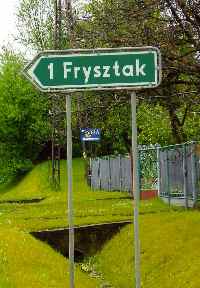
 July05
July05

This year Goldie Apfelbaum Weiskopf visited Frysztak with her two uncles who had been born there. She told me the stories her father, another survivor, had relayed to her.
There were many areas that she wanted to see for herself including ...
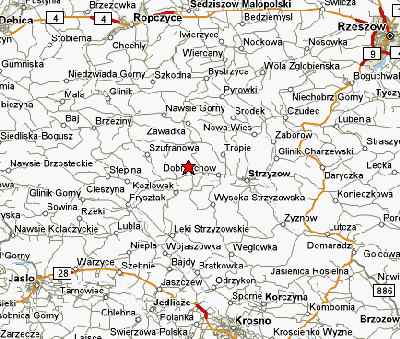 forest of Warycze, where the Frysztak Jews were taken and slaughtered by the Nazis, and
forest of Warycze, where the Frysztak Jews were taken and slaughtered by the Nazis, and
There were over 100 Jews that hid in that forest, but only 3 survived the war; Goldie's father, mother and one of her uncles.
On the left is a map of the area...the red star is the Marrkeshif forest, below it and to the left
is Frysztak, and if you look to the south, toward the road marked #28, on a straight line toward
Jaslo, you will see Warycze on the map.
The first stop they made was at Warycze. The photograph to the right shows
the Plaque...a memorial stone showing
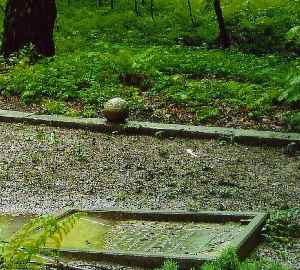 where the mass grave is, commemorating the tragedy of that horrible day.
where the mass grave is, commemorating the tragedy of that horrible day.
T the photograph on the left is one of Goldie's uncle standing at the grave of his mother, in
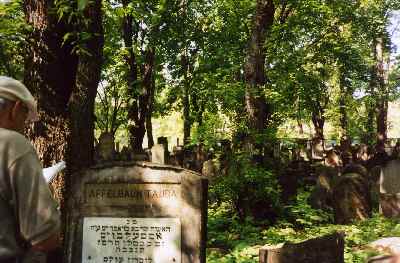 Krakow.
Krakow.
Frysztak today is in a beautiful setting, as you can see in the photograph
below. The houses seem to cluster amid
wonderful folliage on the hillside...tranquil and welcoming.
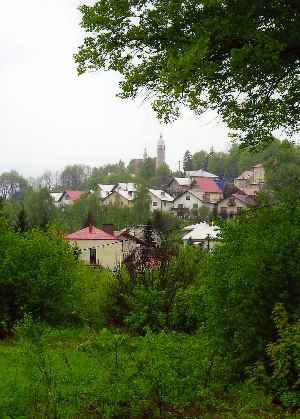
Goldie also visited the grandchildren of the Polish family who had kept her family hidden for 13 months, at great peril. The families have been in touch over these many years.
The main street is quite modern; it even has a computer store!
My father, Edward Preston Jr, and I went on a genealogy quest in April 2004. My grandfather, Edward Preston Sr was born in Frysztak on either September 3 or 13, 1892. He came to America as a young man and enrolled in the US Army. His enrollment name was Edward PRZYSTAS, from Warsto, Frysztak, Austria. Sometime after his separation from the Army he changed his surname to PRESTON.
Prior to our trip, I went to an online Polish-American translation site to make up some 50-plus note cards. Some of those printed included: "we are searching for my father; do you know the name PRZYSTAS and where can I find marriage, birth, baptism, death records, etc." I should have printed 500 as there was such a huge language barrier. The one priest we met at the Catholic Church in Frysztak tried to help us, but due to the language difficulties, we both became frustrated. He said that perhaps some of the records were located in Niewodna, but all attempts to find someone there were fruitless.
This family history began in the early 1970s, and we are about to give up entirely. Any help would be greatly appreciated. Please email me by clicking here.
(Editor) Below are some of the photographs that Lisa sent from her trip to Frysztak:
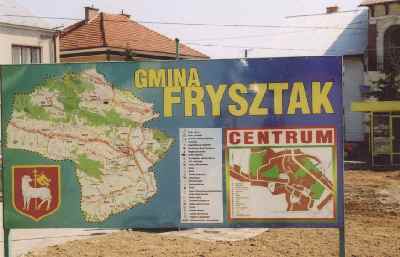 The first photograph shows the tourist information board, located at one end of the town, on the main street.
The board shows a land
map of the roads surrounding and leading into Frysztak.
The first photograph shows the tourist information board, located at one end of the town, on the main street.
The board shows a land
map of the roads surrounding and leading into Frysztak.
To the right is the memorial stone which shows 700 years of Frystzak. Flowers are planted below, in
Roman numeral form, of the number 700.

The Catholic Church is at the opposite side of the town.
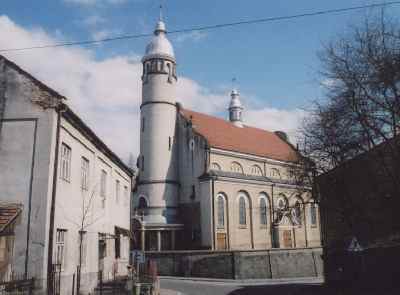
This is the main street of Frysztak, approximately 600 meters in length. Shops include:
Post Office, Flowers,
Fruit and Vegetable Store, Stationary, Ice Cream, Dry Goods store and a very small Hotel.

More of Lisa's photographs are below, in the Cemetery section.
Return to Frysztak Table of Contents
As reported by the US Commission in 1992, Frysztak, also known as Fristik (Yiddish), Twierdza (Polish), Freystath (German) has two Jewish cemeteries.
The first cemetery is located in Rzeszzowst, south from Market Sq. The Orthodox Jewish cemetery was established in the 17th century. The date of the last Jewish burial was before WW II. The cemetery is not listed or protected as a landmark or monument. The cemetery location: urban, on a hillside and is isolated with no marker. It is reached by turning directly off a public road. Access is open to all. The cemetery is not surrounded by wall or fence. Approximate size of cemetery before WW II was 700 square meters. There are about 20 stones in their original location, and others toppled or broken; the stones are from the 18th through the 20th century, some with Hebrew inscriptions. The present owner is the municipality, with recreational and residential properties adjacent to cemetery. The cemetery is visited rarely by local visitors. It is known to have been vandalized during WW II but not in the last ten years. There has been no maintenance. There is no care now.
A second cemetery reported is on Parkowa St. (We are not sure if this is duplicate or different information) The communities of Ciesryni, Tluts, Glink. Luble, and Twierdrs used the cemetery. The cemetery was 100 m from the congregation that used it. The cemetery location is on a hillside, isolated, with no marker, wall or fence. The oldest known gravestone is dated 1878. Tombstones in the cemetery are datable from 19th and 20th century. Tombstones are made of graves. The present owner is the municipality. The cemetery is visited rarely, It is known to have been vandalized during WW II but not in the last ten years. There has been no maintenance.
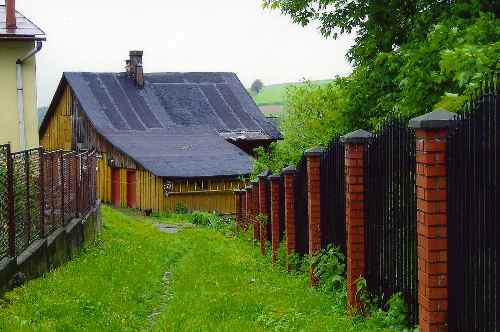 the London Hasidic Bobover community has placed a
beautiful brick and wrought iron wall around the Frysztak Jewish Cemetery to
protect it from any damage. The community had the cemetery wall built because
the daughter of one of the great Bobover Rebbes is buried there.
the London Hasidic Bobover community has placed a
beautiful brick and wrought iron wall around the Frysztak Jewish Cemetery to
protect it from any damage. The community had the cemetery wall built because
the daughter of one of the great Bobover Rebbes is buried there.
Goldie Apfelbaum Weiskopf was told that the building in the center of the
photograph was built on the site of the original synagogue.
Thank you Goldie for bringing back and sharing these memories and wonderful photographs.
Lisa also sent us photographs of the Jewish Cemetery. She wrote: "here is the main entrance to the Jewish Cemetery.
The cemetery is approximately 50 meters south of the Main Street. The gate was locked at the time of
our visit.
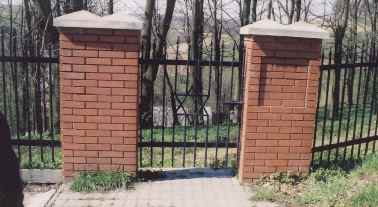
There were a few remaining erect headstones. And a small gated area, possibly a family plot, located inside the cemetery.
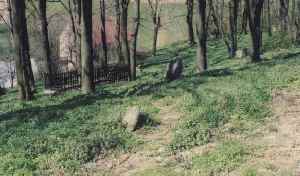 The cemetery slopes downward toward the South....Many of the headstones were lying on the ground. We could not see any
words or symbols on them."
The cemetery slopes downward toward the South....Many of the headstones were lying on the ground. We could not see any
words or symbols on them."
Thank you Lisa, for your wonderful photographs
For a great writeup on the Frysztak cemetery and more photographs, see the Polish Cemetery website at http://www.kirkuty.xip.pl/frysztak.htm; or just click here here.
Return to Frysztak Table of Contents
Childhood: We lived in a small village surrounded by hills, mountains, forests and farms. The name of the village was Frysztak which in German means breakfast....once a German general fought a battle around the village, which is on a big hill. When he reached the top of the hill he took a rest and had breakfast. After that he gave the area the name Frysztak. And that is how this little village in which I was born got its name.
There are now about 3000 people living in the village of Frysztak. Until 1942 about 1600 Jewish people lived there. Most were economically poor. There were two big synagogues plus a few small houses where people gathered for worship and gossip. There was always much fun and happiness.
There was a big church for the gentiles. The new public school was completed about ten years before the war began in 1939. It was in this village public school where I received my seven years of schooling. On one side of the hill just before the village was a gentile cemetery. On the other side of the hill was Jewish cemetery. It is here that my grandparents, my father's parents lie, may they rest in peace.
Stempina. My father was born about three miles from Frysztak...in Stempina. This was only farm land surrounded by mountains and hills. My grandparents' house was at the foot of a hill. About 100 yards from it ran a little river. My grandparents made a living by running a guest house and a tavern where the farmers used to gather after work, have a drink and enjoy themselves. ...My father's only education was in Hebraic subjects. He couldn't read or write Polish. At 15 years of age, my father was already independent and by the standards of the day conducted big buisness...In 1911 he married and moved to Frysztak where he bought the house in which we lived till the end. In 1912 my oldest brother Leibish, was born. At that time people didn't plan how large their family should be. Whatever G-d gave wa good. ...My father was called into the army before I was born. My mother was left with a little child and another expected. It was very difficult for my mother to support herself. There were no benefits and there was no relief or assistance from the government.
I remember... my grandmother because she always used to come when my mother had a baby. She would stay for a week in our house in Frysztak. It was the practice at the time to have a baby at home. We didn't even have a hospital. Everybody called a special woman, a midwife, and this worked out fine.
I went to Hebrew school in the morning and also in the late afternoon. We had a little farm and my father was in the cattle business, so there was plenty of work from early morning till late at night....preparing food for the cows, bringing water from the well, cleaning the stables; it was never finished...for example, I had to bring water and this was not like here a turn of the faucet and the water runs. To bring the water I had to go up a big hill carrying two buckets. Sometimes it was very icy and slippery. Yes, I had to go a few times because we always had a few cows so we needed a lot of water .......when I was six years old I started to go to public school also. Every morning I used to get up at six o'clock to go to shul with the rebbi to daven. After davening we went to his house to learn till 8:30. I went to public school until one o'clock. At that time I came home and had something to eat. I wanted to start some school homework, and the teacher gave us plenty of homework, but I had orders to do ten different jobs in the house. By four or five o'clock I had to go back to Hebrew school till eight o'clock when I came home. I used to carry a kerosene lamp because it was dark and without it I was afraid. After I came home and ate supper I had to do some more work. Finally I started to do my school homework, I was so tired that I could not keep my eyes open, but I had to do it. We did not know any different. We wer glad that we had something to eat. This went on week after week...life was always very hectic. Many times I fell asleep with my clothes on and slept that way till morning.
At that time people did not have luxuries. If anybody had something to eat and had one suit they were happy. Nobody thought different because many people had a hard time making a living. Even with all this hardship people were happy and more satisfied than they are today with all the luxuries. On Saturday and on all holidays everybody went to shul and you could not see sadness on anybody's face. On Saturday night and on Sunday people gathered together and played cards. This was mostly in the winter. After they played a while tea was served with cookies.
In the summer time I used to buy small chicks and raise them for a couple of months. I also bought some old scrap steel and sold it. This way I made some money to cover my school expenses and even bought some clothes for myself.
Now I want to tell a very special story that shows special sorrow and fun. Across the street from us there sued to live in an old house a poor little man. He was in his seventies. They used to call him Mendel Nebech. He had an old and sick wife. She died very suddenly. His old house was very big and he also had a piece of extra land. He had a buyer for his old house. The man's name was Meyer Haber. The old man sold his house with the option that in the back of the new house which was supposed to be built there should be built a little house for him. So the deal went through. First he built for himself the little house in the back. It had one room and a little kitchen. Now the real fun began. In a very short while this old man announced that he was engaged to a girl from Jaslo. This was ten miles from our town. This girl was not even thirty years old. In a few weeks he went to Jaslo to get married. While he went to get married the boys and men from the neighborhood got busy. They prepared a big welcome for the newlyweds with trees and flowers, nice decorations and big signs. It was a lot of fun. The planners for this project were primarily Shmuel Bigayer, Manes Lew, Gershon Birman and Natan Kleinman plus a few others.
As time went on my father diversified his business. For example he bought from big farmers a lot of acres of hay. This had to be cut, dried and stored till spring of the following year and then sold. We also bought from the farmers a lot of apple orchards. I used to go (to the rented stable at a big farm) with the horse and wagon or the sleigh if there was deep snow, and bring the milk to the milk processing factory where they used to make cheese for export...after I had to go to the village Frysztak to buy shredded grain for feeding the cattle. We needed twelve pounds of grain for each head of cattle.
While everyone in town was busy trying to make a living, Hitler was trying to come to power. But people in our village did not know anything about what was going on in the world. There was no television, no radio; I don't even remember if there was a newspaper. Even if there was, not many people could afford to buy one. In Poland antisemitism was growing like mushrooms and getting worse every day.
The church poisoned the minds of the people. When we went to the country to buy something from the farmers, kids 10 years old used to throw stones at us...Poland was an agricultural country. There was very little industry and none in the small towns. Girls could not get married if they did not have money for a dowry and the boys didn't have the means to make a living. (Some) had the money and could emigrate out of the country...but people didn't have the knowledge and foresight. Only a few people from our town went to Israel, but only because they couldn't make a living and they were very poor. They sought the means to go where it was possible to make a living.
In 1933 Hitler came to power and even at that time people didn't think about the consequences because everybody was occupied with everyday life and hardships. Old clothes and things were never thrown out. Things were always passed from the older to the younger. Nothing was wasted. Everything was like a treasure.
At that time Hitler demanded part of Czechoslovakia's Sudentenland from the Czechs. Poland joined the bandwagon and also demanded a part of Czechoslovakia near Cieszyn which was where I was stationed. The Czechs didn't want to give Poland anything. So the situation was very tense. Wee took our position to start shooting but we were waiting for orders. In the end Czechoslovakia agreed to give Poland what they wanted. I would like to emphasize that if England and France hadn't pressured the Czechs to give the land in order to avoid a war we would have taken a very big beating. The Czechs had on their side very good fortifications and were better prepared than we were. They also had better arms. But Hitler's politicians knew that in a short time theywould invade Poland, so this time they wanted to appear to show the Poles a good gesture so it would be easier for them.
Finally at the end of November we got the news that we would go home. I took the train to Krakow and went to visit my mother's grave. While I was in Krakow I was faced with a terrible shock. I saw hundreds of Jews who left, or more correctly, were forced to leave Germany with only their clothes. It was heartbreaking.
The Frysztak Area: This area was very important for strategic reasons. In 1940, during the war Hitler built his headquarters right where my grandparents used to live. Thousands of Jewish slaves worked here to build the railroads, tunnels, barracks, and fortifications for the Germans. I myself worked on the railroads and the barracks which became Hitler's headquarters.
Early 1940: We had all kinds of hardships from the Germans. Everyday we had to go to work to build their barracks, roads and such. In Stempina where my grandparents lived before the war, the Germans built Hitler's headquarters. Every day there were raids to go to work. Life was very tense. The winter of 1940 was very cold with much snow. Every day the whole village had to go clear the snow for the Germans. To this day I can't forget the bitter cold of that winter....The winter of 1941 came. It was another strong winter with big snowfalls. More importantly there were a lot of rumors that the Germans were preparing to go to war with the Russians...For the first few months the Germans moved through Russia without a stop. They took hundreds of thousands of Russian prisoners and shipped them day and night by train or on foot to the camps where they were liquidated. When the winter of 1941 and 1942 came the Germans were stopped by the Russians. The winter played a big role because the Germans weren't prepared for such cold weather. Thousands of German soldiers froze to death....In the beginning of 1942 Hitler gave an order that all Jewish people had to give away all their furs to the German army. One day while I was working on the roads to clear away the snow, a few Gestapo soldiers came to our village with trucks and demanded all the furs. On the spot they killed five people to make sure that everybody would give away their furs. They made a law that if any fur was found with a Jew this person would be shot. In our house we had a lot of furs because it was the style to wear the fur under the coat because the climate was so cold. I myself had one. When we had to give it away we stripped all the furs off. Some we gave to the Germans and some we hid by the Gentile people.
We thought that while we were working we would be protected from being sent away to the camps... While I was in the countryside I would search for a lot of things. First I was looking around in case we had to run away from the city. We needed someone to help us hide and especially someone we could trust. We also needed a place where we could store things like clothes, bedding and all our other things from the house. We knew all these people for many years but even so when the time came and we needed help we were very disappointed. Some farmers we were even afraid to go to. We planned these things while we were still in our home before the Germans came to liquidate the Jews from the whole village.
Spring of 1942:
In the spring of 1942 we heard of the mass deportation of the Jews to the concentration camps. The times were very tense..... When I came home Wednesday night I heard all the news. Thursday morning the Gestapo again gave an order that Friday morning every living Jew ... should come to the market place....on this day over a thousand people were killed in Warzyce and buried in the mass grave....When this was finished they took over one hundred young boys on trucks and sent them to Pustkow. This was a concentration camp forty miles from our village....but they were sent back.
I knew that it is hard to believe but whatever I describe, things were actually a hundred times more and worse.
The next week the Gestapo took a couple of hundred young men and shipped them to the concentration camp Plaszow.
I met the new Jewish leader from the Judenrat, Berglass. He told us that he had just come from Jaslo from the Gestapo. He said that tomorrow or the day after all the Jews from the village would be taken away. He said that anybody who had any chance or means to escape should try because there was nothing to lose.
Thirty Years Later..The Trial:
Thirty years passed with not even one moment's freedom from my memories. I would read the English and the Yiddish newspapers to find out and to hear something about the murderers from our village and surrounding vicinity. Finally in the spring of 1972 I bought the Jewish Forward and ...saw an article that the German government was looking for people to testify at a trial taking place in Armstack, Germany. They were looking for people from our village who were present when the Gestapo killed over 1000 men, women and children in Warzyce....the defendents were six Gestapo men who were responsible for deporting and killing all the Jews from our village and surrounding villages....in a short time we received papers and airline tickets and also money to come to testify on a specific date....the trial began at nine o'clock. The first witness was my brother Aaron...I wa called to the stand the following morning, Wednesday, July 5, 1972....i arrived early to see the Nazi murderers. I was very nervous...I could recognize only one of them...the Nazi who had held a bayonet to my stomach...there were several things that made the identification difficult. Thirty years had passed. In 1942 they had all been young men in uniforms. Also at that time we were too frightened to even look at them directly...consequently it was not easy for me to be exactly certain....this trial had been in progress for more than two years. There had been witnesses from Israel, Canada, Australia, Poland and other countries. Six months later I called Dr. Karlbach at the Forward newspaper and received the information that the criminals were each given five years in prison for their crimes.
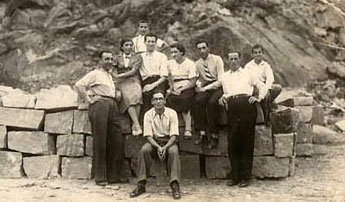 The people in the photograph to the right are from Frysztak and include Jacob's wife and brother in law. The photograph was taken around 1935.
The people in the photograph to the right are from Frysztak and include Jacob's wife and brother in law. The photograph was taken around 1935.
At that time they didn not have trucks or cars. Everything-food, clothes, ammunition, a kitchen and even a hospital was transported with a horse and wagon. The whole regiment had about 2500 men. As usual the officers and the staff rode the horses or the wagons.
. .
. .
Holocaust Memories: Jack Apfelbaum
... ... ...
Return to Table of Contents